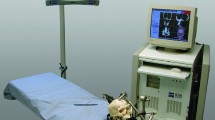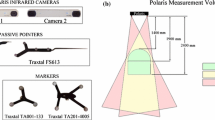Abstract
Purpose
A patient registration and real-time surgical navigation system and a novel device and method (Noctopus) is presented. With any tracking system technology and a patient/target-specific registration marker configuration, submillimetric target registration error (TRE), high-precise application accuracy for single or multiple anatomical targets in image-guided neurosurgery or ENT surgery is realized.
Methods
The system utilizes the advantages of marker-based registration technique and allows to perform automatized patient registration using on the device attached and with patient scanned four fiducial markers. The best possible sensor/marker positions around the patient’s head are determined for single or multiple region(s) of interest (target/s) in the anatomy. Once brought at the predetermined positions the device can be operated with any tracking system for registration purposes.
Results
Targeting accuracy was evaluated quantitatively at various target positions on a phantom skull. The target registration error (TRE) was measured on individual targets using an electromagnetic tracking system. The overall averaged TRE was 0.22 ± 0.08 mm for intraoperative measurements.
Conclusion
An automatized patient registration system using optimized patient-/target-specific marker configurations is proposed. High-precision and user-error-free intraoperative surgical navigation with minimum number of registration markers and sensors is realized. The targeting accuracy is significantly improved in minimally invasive neurosurgical and ENT interventions.










Similar content being viewed by others
References
Maurer CR, Fitzpatrick JM, Wang MY, Galloway RL, Maciunas RJ, Allen GS (1997) Registration of head volume images using implantable fiducial markers. IEEE Trans Med Imaging 16(4):447–462
Luebbers H, Messmer P, Obwegeser JA, Zwahlen RA, Kikinis R, Graetz KW, Matthews F (2008) Comparison of different registration methods for surgical navigation in craniomaxillofacial surgery. J Craniomaxillofac Surg 36(2):109–116
Horn Berthold KP (1987) Closed-form solution of absolute orientation using unit quaternions. J Opt Soc Am 4(4):629–642
Besl P, McKay H (1992) A method for registration of 3-D shapes. IEEE Trans Pattern Anal Mach Intell 14(2):239–256
Fitzpatrick JM, Milan S (2009) Handbook of Medical Imaging, Volume 2. Medical Image Processing and Analysis, Chapter 8: Image Registration PM80, ISBN: 9780819477606
Eggers G, Mühling J, Marmulla R (2006) Image-to-patient registration techniques in head surgery. Int J Oral Maxillofac Surg 35(12):1081–1095
West JB, Fitzpatrick JM, Toms SA, Maurer CR, Maciunas RJ (2001) Fiducial point placement and the accuracy of point-based, rigid body registration. Neurosurgery 48(4):810–816
Pillai P, Sammet S, Ammirati M (2008) Application accuracy of computed tomography based, image-guided navigation of temporal bone. Neurosurgery 63(4 Suppl 2):326–332
Grauvogel TD, Soteriou E, Metzger MC, Berlis A, Maier W (2010) Influence of different registration modalities on navigation accuracy in ear, nose, and throat surgery depending on the surgical field. Laryngoscope 120(5):881–888
Hofer M, Dittrich E, Baumberger C, Strauss M, Dietz A, Lüth T, Strauss G (2010) The influence of various registration procedures upon surgical accuracy during navigated controlled petrous bone surgery. Otolaryngol Head Neck Surg 143(2):258–262
Helm PA, Eckel TS (1998) Accuracy of registration methods in frameless stereotaxis. Comput Aided Surg 3(2):51–56
Metzger MC, Rafii A, Holhweg-Majert B, Pham AM, Strong B (2007) Comparison of 4 registration strategies for computer-aided maxillofacial surgery. Otolaryngol Head Neck Surg 137(1):93–99
Vrionis FD, Foley KT, Robertson JH, Shea JJ (1997) Use of cranial surface anatomic fiducials for interactive image-guided navigation in the temporal bone: a cadaveric study. Neurosurgery 40(4):755–764
Villalobos H, Germano IM (1999) Clinical evaluation of multimodality registration in frameless stereotaxy. Comput Aided Surg 4(1):45–49
Wolfsberger S, Rössler K, Regatsching R, Ungersböck K (2002) Anatomical landmarks for image registration in frameless stereotactic neuronavigation. Neurosurg Rev 25(1–2):68–72
Woerdeman PA, Willems PWA, Noordmans HJ, Tulleken CAF, Sprenkel JWB (2007) Application accuracy in frameless image-guided neurosurgery: a comparison study of three patient-to-image registration methods. J Neurosurg 106(6):1012–1016
Shamir RR, Joskowicz L, Spektor S, Shoshan Y (2009) Localization and registration accuracy in image guided neurosurgery: a clinical study. Int J Comput Assist Radiol Surg 4(1):45–52
Kremser C, Plangger C, Bösecke R, Pallua A, Aichner F, Felber SR (1997) Image registration of MR and CT images using a frameless fiducial marker system. Magn Reason Imaging 15(5):579–585
Steinmeier R, Rachinger J, Kaus M, Ganslandt O, Huk W, Fahlbusch R (2000) Factors influencing the application accuracy of neuronavigation systems. Stereotact Funct Neurosurg 75(4):188–202
Hardy SM, Melroy C, White DR, Dubin M, Senior B (2006) A comparison of computer-aided surgery registration methods for endoscopic sinus surgery. Am J Rhinol 20(1):48–52
Yinlong L, Zhijian S, Manning W (2017) A new robust markerless method for automatic image-to-patient registration in image-guided neurosurgery system. Comput Assist Surg 22(1):319–325
Mongen MA, Willems PWA (2019) Current accuracy of surface matching compared to adhesive markers in patient-to-image registration. Acta Neurochir 161:865–870
Raabe A, Krishnan R, Wolff R, Hermann E, Zimmermann M, Seifert V (2002) Laser surface scanning for patient registration in intracranial image-guided surgery. Neurosurgery 50(4):797–801
Schlaier J, Warnat J, Brawanski A (2002) Registration accuracy and practicability of laserdirected surface matching. Comput Aided Surg 7(5):284–290
Mascott CR, Sol J, Bousquet P, Lagarrigue J, Lazorthes Y, Lauwers-Cances V (2006) Quantification of true in vivo (application) accuracy in cranial image-guided surgery: influence of mode of patient registration. Neurosurgery 59(1):146–56
Arapakis I, Hubbe U, Maier W, Laszig R, Schipper J (2005) LED-Autoregistrierung in der navigierten endonasalen Nasennebenhöhlenchirurgie. Laryngorhinootologie 84(6):418–425
Makiese O, Pillai P, Salma A, Sammet S, Ammirati M (2010) Accuracy Validation in a Cadaver Model of Cranial Neuronavigation Using a Surface Autoregistration Mask. Neurosurgery 67:85–90
Bardosi Z (2015) OpenCL accelerated GPU binary morphology image filters for ITK. Insight J
Fitzpatrick JM, West JB, Maurer CR (1998) Predicting error in rigid-body point-based registration. IEEE Trans Med Imaging 17(5):694–702
Zannoni C, Viceconti M, Pierotti L, Cappello A (1998) Analysis of titanium induced CT artifacts in the development of biomechanical finite element models. Med Eng Phys 20(9):653–659
Funding
This study was funded by Austria Wirtschaftsservice (AWS) under the project number P2407952-PSL01 and partly funded by Medical University of Innsbruck under the project number D-153110-015-014.
Author information
Authors and Affiliations
Corresponding author
Ethics declarations
Conflict of interest
The authors declare that they have no conflict of interest.
Ethical approval
This article does not contain any studies with human participants or animals performed by any of the authors. This article does not contain patient data.
Additional information
Publisher's Note
Springer Nature remains neutral with regard to jurisdictional claims in published maps and institutional affiliations.
Rights and permissions
Springer Nature or its licensor (e.g. a society or other partner) holds exclusive rights to this article under a publishing agreement with the author(s) or other rightsholder(s); author self-archiving of the accepted manuscript version of this article is solely governed by the terms of such publishing agreement and applicable law.
About this article
Cite this article
Özbek, Y., Bárdosi, Z. & Freysinger, W. Noctopus: a novel device and method for patient registration and navigation in image-guided cranial surgery. Int J CARS (2024). https://doi.org/10.1007/s11548-024-03135-w
Received:
Accepted:
Published:
DOI: https://doi.org/10.1007/s11548-024-03135-w




